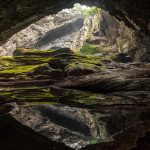Quang Binh: the land of 500 caves
With the recent discovery of 22 more caves, the central province of Quang Binh, renowned as Vietnam’s cave kingdom, now boasts over 500 caves, with about 40 open for tourism.

On April 14, Pham Hong Thai, Director of Phong Nha – Ke Bang National Park, announced that an expedition team had discovered 22 caves in Minh Hoa and Tuyen Hoa districts during a recent survey, and an additional three caves the Va, Doi Trieng 2, and Tien cave system, combining for a total length of 3,550 meters.
The photograph above captures the expedition team at a newly discovered cave area in Tuyen Hoa. With a plethora of caves, both large and small, already accessible for tourism, Quang Binh has earned its title as the kingdom of caves.
Photo courtesy of the expedition team

Phong Nha Cave
Phong Nha Cave stands as one of Quang Binh’s most sought-after destinations for tourists. Nestled within Phong Nha – Ke Bang National Park, a UNESCO World Natural Heritage site, it is located in Son Trach Commune, Bo Trach District, approximately 45 kilometers from Dong Hoi City.
Having been explored numerous times since the early 20th century, Phong Nha Cave garnered recognition in 1994 when a report on a geomorphological survey of Vietnam by a renowned British exploration group hailed it as “one of the two most beautiful water caves in the world.” Serving as the flagship attraction within Phong Nha – Ke Bang National Park, it was among the first sites opened for tourism in the area.
To embark on an exploration of Phong Nha Cave, visitors purchase tickets from the Phong Nha Tourism Center, then board a boat journey along the Son River, enjoying a 30 minute journey before entering the cave. Inside, visitors are greeted by stalactites and other natural wonders.
Photo courtesy of Quang Binh Tourism

Paradise Cave
Paradise Cave, situated in Phong Nha – Ke Bang National Park, lies 60 kilometers northwest of Quang Binh’s capital city Dong Hoi. Discovered in 2005, Paradise is a dry cave, distinct from Phong Nha Cave as it lacks an underground river. Its terrain mostly consists of soft and flat ground, and the cave’s temperature remains consistently around 10 degrees Celsius cooler than outside.
To reach Thien Duong Cave, visitors depart from the west branch of the Ho Chi Minh Highway, traveling approximately 5 kilometers before ascending over 520 steps to access the cave entrance. The cave path extends for 1.1 kilometers.
Photo courtesy of Wiki

Son Doong Cave
Son Doong Cave holds the distinction of being the largest cave in the world. Discovered by Ho Khanh, a native of Phong Nha, in 1990, it underwent survey and measurement by an English-Vietnamese cave exploration group in 2009. Subsequently, in 2013, Son Doong earned recognition from the Guinness World Records as the world’s largest natural cave.
With a total length of nearly 9 kilometers and a vast cave arch, Son Doong Cave boasts a volume of 38.5 million cubic meters. Within its chambers, visitors encounter towering stalactites, some exceeding 80 meters in height, alongside a primeval forest, unique ecosystem, and an underground river.
Offered as an adventure tourism experience, Son Doong cave exploration tours span 6 days and 5 nights, with bookings available since 2013. Demand for these tours remains consistently high, often fully booked a year in advance. This photo captures the Dinosaur Echo at Sinkhole 1 within Son Doong Cave.
Photo courtesy of Oxalis

Tu Lan cave system
The Tu Lan cave system is nestled within the primeval forest and limestone mountains spanning over 650 hectares in Tan Hoa Commune, Minh Hoa District. The cave system is connected to eight different valleys and mountain ranges via underground rivers and cave passages, which are all outside of Phong Nha – Ke Bang National Park.
Comprising 20 caves, this system was explored in 1992 by a joint Vietnamese and English cave exploration team. Subsequent extensive surveys were conducted from 2010 onwards.
The above photograph showcases the stalactite columns found within Tu Lan Cave.
Photo courtesy of Oxalis

Ba Cave
Situated within the heart of Phong Nha – Ke Bang National Park, the Ba Cave area lies within the park’s strictly protected zone. This expanse is adorned with ancient forests featuring millennia-old trees, providing habitat for rare animal species.
Among the features of this area are several large caves, each adorned with diverse stalactite formations. These caves were discovered and mapped by a joint British-Vietnamese cave exploration team in 1992 and 1994.
Scheduled for development into an adventure tourism destination in 2022, this area offers exhilarating experiences for adventurers.
This image captures the Sang Cave campsite during the Ba Cave deep jungle expedition.
Photo courtesy of Oxalis

Va Cave
Va Cave, situated within the core area of Phong Nha – Ke Bang National Park, and it is situated around 4 kilometers away from the west branch of the Ho Chi Minh Highway.
Known as an underground water cave, Va Cave has a stalagmite system featuring around 1,000 conical-shaped stalactites of uniform size. These formations have developed within sedimentation lakes, with stalagmite towers characterized by steep slopes, reaching heights of up to 2 meters. These columns are covered in a layer of soft mud.
Photo courtesy of Oxalis



















